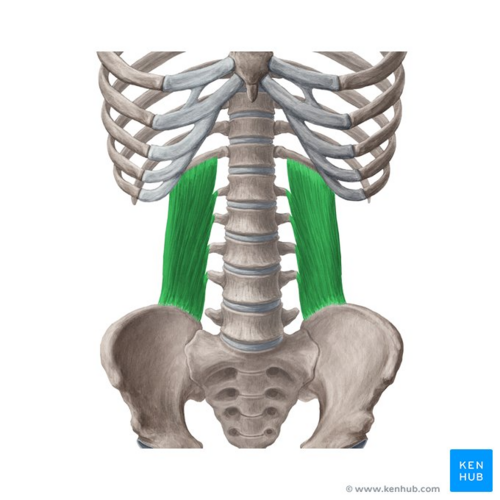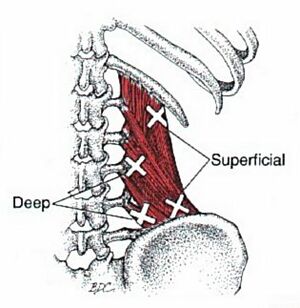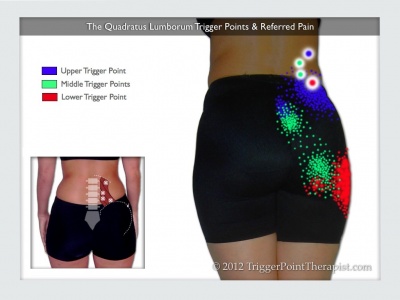Quadratus Lumborum: Difference between revisions
Ahmed Nasr (talk | contribs) No edit summary |
Kim Jackson (talk | contribs) m (Text replacement - "[[Multifidus Muscle" to "[[Lumbar Multifidus") |
||
| (19 intermediate revisions by 5 users not shown) | |||
| Line 3: | Line 3: | ||
'''Top Contributors''' - {{Special:Contributors/{{FULLPAGENAME}}}} | '''Top Contributors''' - {{Special:Contributors/{{FULLPAGENAME}}}} | ||
</div> | </div> | ||
== | == Introduction == | ||
[[File:Quadratus lumborum - Kenhub.png|alt=Quadratus lumborum (highlighted in green) - anterior view|right|frameless|500x500px|Quadratus lumborum (highlighted in green) - anterior view]] | |||
The Quadratus Lumborum (QL) is the deepest [[Back Muscles|back muscle]] and originates from the [[Ilium|iliac crest]] and inserts on the transverse process of [[Lumbar Vertebrae|lumbar]] one through five and the lower part of the twelfth [[Ribs|rib.]] The QL muscle is flattened and has a quadrangular shape. | |||
The | The QL muscle is an integral part of the [[Thoracolumbar Fascia|thoracolumbar]] fascia, a [[Myofascial Pain|myofascial]] system that covers the posterior area of the human body, involving part of the lower and upper limbs. | ||
Innervation of the QL is via the twelfth [[Thoracic Spinal Nerves|thoracic nerve]] and the spinal rami of the lumbar [[Spinal Nerves|spinal nerves]]. | |||
= | Along with the [[Lumbar Multifidus|multifidus]] and [[Erector Spinae|erector spinae]] muscles, the QL helps to create an antagonist force to the [[Abdominal Muscles|muscles of the anterolateral abdomen wall.]]<ref name=":1">Bordoni B, Varacallo M. [https://www.ncbi.nlm.nih.gov/books/NBK535407/ Anatomy, Abdomen and Pelvis, Quadratus Lumborum].2018 Availkable: https://www.ncbi.nlm.nih.gov/books/NBK535407/<nowiki/>(accessed 13.2.2022)</ref> | ||
Image: Quadratus lumborum (highlighted in green) - anterior view<ref >Quadratus lumborum (highlighted in green) - anterior view image - © Kenhub https://www.kenhub.com/en/library/anatomy/quadratus-lumborum-muscle</ref> | |||
== | == Anatomy == | ||
[[File:Muscles of the Abdomen Posterior.png|thumb|437x437px|Muscles of the Abdomen Posterior]] | |||
The muscular organization is complex (comprises three layers with muscle fibers that have different vectors) and it is difficult to identify precisely the actions that occur through the contraction of fibers. | |||
Generally, the QL muscle is located medially to the [[aponeurosis]] of the [[Transversus Abdominis|transverse abdominal muscle]]. | |||
The quadratus lumborum (QL) muscle is: | |||
* An integral part of the thoracolumbar fascia and also | |||
* One of the muscles of the posterior [[Abdominal Muscle Anatomy|abdominal wall]]. | |||
* One of the [[Core Muscles]]<ref name=":1" /> | |||
* One of the [[Paraspinal Muscles|paraspinal muscles]] | |||
=== Origin === | |||
[[Iliolumbar ligament]] and internal lip of Posterior iliac Crest.<ref name="anatomy expert">Anatomy expert. 3D - Quadratus lumborum. Available from: http://www.anatomyexpert.com/app/structure/5307/ (accessed from 19 April 2019)</ref><ref name=":0">Keith L. , Anne M. R . Clinically Oriented Anatomy 7th edition. philidephia : Lippincott Williams & Wilkins.2017</ref> | |||
=== | === Insertion === | ||
Medial half of lower border of 12th rib and tips of transverse processes of lumbar vertebrae.<ref name="anatomy expert" /><ref name=":0" /> | |||
=== Nerve Supply === | |||
* Subcostal nerve (T12)<ref name="anatomy expert" /> | |||
* Iliohypogastric and Ilioinguinal nerve (both from L1)<ref name="anatomy expert" /> | |||
* Branches from the ventral rami (L2 and L3)<ref name="anatomy expert" /> | |||
== Function == | == Function == | ||
[[File:LumbarTriangle.jpeg|thumb|630x630px|Quadratus lumborum visible]] | |||
The anatomy texts describe the quadratus lumborum muscle as an extensor of the lumbar spine, a [[Lumbar Instability|stabilizer of the lumbar]] area, capable of [[Pelvic Tilt|pelvic tilting]] laterally and capable of acting as an [[Muscles of Respiration|inspiratory accessory muscle]]. | |||
However findings show | |||
* During extension, the QL exerts a force of 10 N, compared to 100 N and 150 N of the erector spinae muscles and the multifidus. It seems unlikely that it can extend the lumbar area on a sagittal plane with such a small force (10 N). | |||
* The QL during a lateral tilt of the trunk it participates with less than 10% of the force required for a coronal inclination. | |||
It seems likely that QL could act as a crossroad of the forces exerted by the neighboring muscles, influencing the vectors of the different tensions produced, thanks to its :strategic position; disorganised scheme of its fibers; and its function in the myofascial system. | |||
< | === Actions === | ||
Classic described actions given below: | |||
* Quadratus Lumborum fixes the 12th rib to stabilize diaphragm attachments during inspiration<ref name="radiopaedia">Radiopaedia. Quadratus lumborum. Available from: http://radiopaedia.org/articles/quadratus-lumborum (accessed 15 August 2015)</ref> | |||
* Lateral flexes the vertebral column<ref name="radiopaedia" /> | |||
* Extends lumbar vertebrae<ref name="radiopaedia" /> | |||
* It forms with the contralateral [[Tensor Fascia Lata|Tensor fascia lata]] and [[Gluteus Medius|Gluteus medius]] a lateral myofascial sling which aims to maintain frontal plane stability of the pelvis.<ref>Morgan J. Modern Principles of Core Training. Lulu.com, 2010</ref><ref>McCall P. Cutting Edge: Training the Fascial Network (Part 2). Sign.;888:825-3636.</ref><ref>Wallden, M. (2014). ''The middle crossed syndrome – New insights into core function. Journal of Bodywork and Movement Therapies, 18(4), 616–620.'' doi:10.1016/j.jbmt.2014.09.002 </ref> | |||
== | == Physiotherapy Implications == | ||
[[File:Quadratus Lumborum (1).jpg|thumb|Quadratus lumborum trigger points]] | |||
The muscle group is considered a postural muscle group and part of the [[Core Muscles|Core muscles]]. The core is the group of trunk and [[hip]] muscles that surround the spine, abdominal viscera and hip. Core muscles are essential for proper [[Load Management|load]] balance within the spine, pelvis, and [[Kinetic Chain|kinetic chain]]. They spare the spine from excessive load and are essential for lad transfer between the upper and lower body. | |||
= | Quadratus lumborum is a continuation of transverse abdominal muscle. The transverse abdominal muscle is part of the anterior fascial system of the body. The transversalis fascia penetrates the abdominal musculature. It's one of the muscles that tends to be tight and overactive<ref>Page .P, Frank C, Lardner R. Assessment and Treatment of Muscle Imbalance: The Janda Approach .Champaign . Human Kinetics. 2010.</ref> In this situation adversly affects the resting tension of the QL, altering the distribution of the lumbar region load.[[File:Quadratus_lumborum_trigger_points_referred_pain-1024x768.jpg|alt=|right|400x400px|QL trigger points referred pain]] | ||
Trigger points can involve the QL. This condition could also mimic a painful syndrome of the lumbar area. Trigger Point Referral Pattern | |||
For more see [[Quadratus Lumborum Syndrome]] | |||
Lumbar spine pathologies eg bulging discs, and facet joint hypertrophy from chronic inflammation may effect nerve conduction and response to the QL and Iliopsoas resulting in poor muscle stabilisation and mechanical stress from chronic contracture.<ref name="reller">Acupuncture Integrated. Low Back and Lower Body Myofascial Pain Syndromes. Available from: http://www.acupunctureintegrated.com/articles/low-back-and-lower-body-myofascial-pain-syndromes | |||
[accessed 19 April 2019]. | [accessed 19 April 2019]. | ||
</ref> | </ref><br>QL can cause low back pain with the emergence of a heterotopic ossification or myositis ossificans. The latter may result from direct trauma and inadequate healing. | ||
== References == | == References == | ||
<references /> | <references /> | ||
[[Category:Muscles]] | [[Category:Muscles]] | ||
[[Category: | [[Category:Anatomy]] | ||
[[Category: | [[Category:Lumbar Spine]] | ||
[[Category:Lumbar Spine - Anatomy]] | |||
[[Category:Lumbar Spine - Muscles]] | |||
Latest revision as of 10:17, 14 July 2023
Top Contributors - Vanessa Rhule, Lucinda hampton, Kim Jackson, Ahmed Nasr, George Prudden, Joao Costa, Admin, Wendy Walker, Naomi O'Reilly, WikiSysop and Wanda van Niekerk
Introduction[edit | edit source]
The Quadratus Lumborum (QL) is the deepest back muscle and originates from the iliac crest and inserts on the transverse process of lumbar one through five and the lower part of the twelfth rib. The QL muscle is flattened and has a quadrangular shape.
The QL muscle is an integral part of the thoracolumbar fascia, a myofascial system that covers the posterior area of the human body, involving part of the lower and upper limbs.
Innervation of the QL is via the twelfth thoracic nerve and the spinal rami of the lumbar spinal nerves.
Along with the multifidus and erector spinae muscles, the QL helps to create an antagonist force to the muscles of the anterolateral abdomen wall.[1]
Image: Quadratus lumborum (highlighted in green) - anterior view[2]
Anatomy[edit | edit source]
The muscular organization is complex (comprises three layers with muscle fibers that have different vectors) and it is difficult to identify precisely the actions that occur through the contraction of fibers.
Generally, the QL muscle is located medially to the aponeurosis of the transverse abdominal muscle.
The quadratus lumborum (QL) muscle is:
- An integral part of the thoracolumbar fascia and also
- One of the muscles of the posterior abdominal wall.
- One of the Core Muscles[1]
- One of the paraspinal muscles
Origin[edit | edit source]
Iliolumbar ligament and internal lip of Posterior iliac Crest.[3][4]
Insertion[edit | edit source]
Medial half of lower border of 12th rib and tips of transverse processes of lumbar vertebrae.[3][4]
Nerve Supply[edit | edit source]
- Subcostal nerve (T12)[3]
- Iliohypogastric and Ilioinguinal nerve (both from L1)[3]
- Branches from the ventral rami (L2 and L3)[3]
Function[edit | edit source]
The anatomy texts describe the quadratus lumborum muscle as an extensor of the lumbar spine, a stabilizer of the lumbar area, capable of pelvic tilting laterally and capable of acting as an inspiratory accessory muscle.
However findings show
- During extension, the QL exerts a force of 10 N, compared to 100 N and 150 N of the erector spinae muscles and the multifidus. It seems unlikely that it can extend the lumbar area on a sagittal plane with such a small force (10 N).
- The QL during a lateral tilt of the trunk it participates with less than 10% of the force required for a coronal inclination.
It seems likely that QL could act as a crossroad of the forces exerted by the neighboring muscles, influencing the vectors of the different tensions produced, thanks to its :strategic position; disorganised scheme of its fibers; and its function in the myofascial system.
Actions[edit | edit source]
Classic described actions given below:
- Quadratus Lumborum fixes the 12th rib to stabilize diaphragm attachments during inspiration[5]
- Lateral flexes the vertebral column[5]
- Extends lumbar vertebrae[5]
- It forms with the contralateral Tensor fascia lata and Gluteus medius a lateral myofascial sling which aims to maintain frontal plane stability of the pelvis.[6][7][8]
Physiotherapy Implications[edit | edit source]
The muscle group is considered a postural muscle group and part of the Core muscles. The core is the group of trunk and hip muscles that surround the spine, abdominal viscera and hip. Core muscles are essential for proper load balance within the spine, pelvis, and kinetic chain. They spare the spine from excessive load and are essential for lad transfer between the upper and lower body.
Quadratus lumborum is a continuation of transverse abdominal muscle. The transverse abdominal muscle is part of the anterior fascial system of the body. The transversalis fascia penetrates the abdominal musculature. It's one of the muscles that tends to be tight and overactive[9] In this situation adversly affects the resting tension of the QL, altering the distribution of the lumbar region load.
Trigger points can involve the QL. This condition could also mimic a painful syndrome of the lumbar area. Trigger Point Referral Pattern
For more see Quadratus Lumborum Syndrome
Lumbar spine pathologies eg bulging discs, and facet joint hypertrophy from chronic inflammation may effect nerve conduction and response to the QL and Iliopsoas resulting in poor muscle stabilisation and mechanical stress from chronic contracture.[10]
QL can cause low back pain with the emergence of a heterotopic ossification or myositis ossificans. The latter may result from direct trauma and inadequate healing.
References[edit | edit source]
- ↑ 1.0 1.1 Bordoni B, Varacallo M. Anatomy, Abdomen and Pelvis, Quadratus Lumborum.2018 Availkable: https://www.ncbi.nlm.nih.gov/books/NBK535407/(accessed 13.2.2022)
- ↑ Quadratus lumborum (highlighted in green) - anterior view image - © Kenhub https://www.kenhub.com/en/library/anatomy/quadratus-lumborum-muscle
- ↑ 3.0 3.1 3.2 3.3 3.4 Anatomy expert. 3D - Quadratus lumborum. Available from: http://www.anatomyexpert.com/app/structure/5307/ (accessed from 19 April 2019)
- ↑ 4.0 4.1 Keith L. , Anne M. R . Clinically Oriented Anatomy 7th edition. philidephia : Lippincott Williams & Wilkins.2017
- ↑ 5.0 5.1 5.2 Radiopaedia. Quadratus lumborum. Available from: http://radiopaedia.org/articles/quadratus-lumborum (accessed 15 August 2015)
- ↑ Morgan J. Modern Principles of Core Training. Lulu.com, 2010
- ↑ McCall P. Cutting Edge: Training the Fascial Network (Part 2). Sign.;888:825-3636.
- ↑ Wallden, M. (2014). The middle crossed syndrome – New insights into core function. Journal of Bodywork and Movement Therapies, 18(4), 616–620. doi:10.1016/j.jbmt.2014.09.002
- ↑ Page .P, Frank C, Lardner R. Assessment and Treatment of Muscle Imbalance: The Janda Approach .Champaign . Human Kinetics. 2010.
- ↑ Acupuncture Integrated. Low Back and Lower Body Myofascial Pain Syndromes. Available from: http://www.acupunctureintegrated.com/articles/low-back-and-lower-body-myofascial-pain-syndromes [accessed 19 April 2019].











